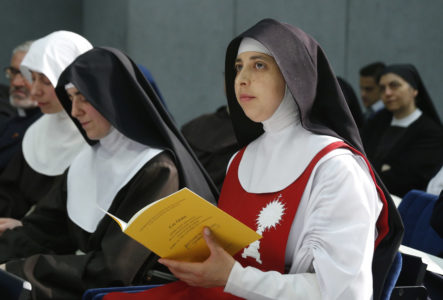By Carol Glatz
VATICAN CITY – The Vatican released an instruction with new norms for contemplative orders of nuns, encouraging cooperation among their monasteries and outlining procedures for communities left with only a few members.
The document, “Cor Orans” (“Praying Heart”) is a follow-up instruction on implementing Pope Francis’ 2016 document “Vultum Dei Quaerere” (“Seeking the Face of God”), which issued new rulings and mandates for monasteries of women around the world. The aim of both, the Vatican said, is to safeguard the identity and mission of contemplative women religious. The pope charged the Vatican Congregation for Institutes of Consecrated Life and Societies of Apostolic Life with creating the new instruction, which seeks to fill the legislative gaps left since Pope Pius XII’s apostolic constitution “Sponsa Christi,” from 1950, and facilitate carrying out the mandates in “Vultum Dei Quaerere.” The instruction was released by the Vatican May 15 and went into effect immediately.
Archbishop Jose Rodriguez Carballo, secretary of the congregation, told reporters one of the most significant changes is requiring a monastery or contemplative community of women religious to have at least eight professed religious women in order to maintain their autonomy. If that number drops to five professed religious, they lose their right to elect a superior, the Vatican congregation is informed of the situation and an ad hoc commission is formed to name an administrator, he said.
The outside intervention is meant to assess whether the community’s difficulties are “temporary or irreversible” and, if temporary, help them overcome the problems so as to avoid their suppression, the archbishop said.

A nun holds a copy of “Cor Orans,” a new instruction for contemplative women religious, during a news conference for its release at the Vatican May 15. The instruction concerns the life, autonomy, supervision and formation of contemplative women religious. (CNS photo/Paul Haring)
The instruction also details the roles, rights and responsibilities federations will have.
Pope Francis’ new ruling included a mandate that all monasteries are to be part of a federation with the aim of facilitating formation and meeting needs through sharing assets and exchanging members; however, a monastery can request an exception from the Vatican.
The new instruction said monasteries have one year to comply until the dicastery assigns them a federation or other form of association.
Father Paciolla said the documents do not change the autonomy of the monasteries or the purpose of a federation, but are meant to bring “balance” to how they can better work together.
The aim, Father Paciolla said, is to open up another channel of communication with the Vatican and foster dialogue and communion when it comes to oversight.
Archbishop Rodriguez Carballo said the instructions, like Pope Francis’ document, are built on the responses received from a questionnaire sent to all contemplative women religious a few years ago.
(Editor’s note: Because these rules are so new, it will take some time to review them to see how they might apply to local communities, including the Carmelite community in the Diocese of Jackson.)
